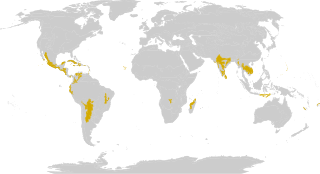
The tropical and subtropical dry forest is a habitat type defined by the World Wide Fund for Nature and is located at tropical and subtropical latitudes. Though these forests occur in climates that are warm year-round, and may receive several hundred centimeters of rain per year, they have long dry seasons which last several months and vary with geographic location. These seasonal droughts have great impact on all living things in the forest.

Olea is a genus of about 40 species in the family Oleaceae, native to warm temperate and tropical regions of the Middle East, southern Europe, Africa, southern Asia, and Australasia. They are evergreen trees and shrubs, with small, opposite, entire leaves. The fruit is a drupe. Leaves of Olea contain trichosclereids.

Cunoniaceae is a family of 27 genera and about 310 species of woody plants in the order Oxalidales, mostly found in the tropical and wet temperate regions of the Southern Hemisphere. The greatest diversity of genera are in Australia and Tasmania, New Guinea, and New Caledonia. The family is also present in Central America, South America, the Caribbean, Malesia, the island of the South Pacific, Madagascar and surrounding islands. the family is absent from mainland Asia except from Peninsular Malaysia, and almost absent from mainland Africa apart from two species from Southern Africa. Several of the genera have remarkable disjunct ranges, found on more than one continent, e.g. Cunonia, EucryphiaWeinmannia sect. Weinmannia.

The Aberdare Range is a 160 km long mountain range of upland, north of Kenya's capital Nairobi with an average elevation of 3,500 metres (11,480 ft). It is located in Nyandarua County, west central Kenya, northeast of Naivasha and Gilgil and just south of the Equator. The mountain range is called Nyandarua among the Agikuyu people in whose territory this forest and mountain range is located. The name Nyandarua comes from the Kikuyu word rwandarua meaning a drying hide, due to the distinctive fold of its silhouette.
An evergreen forest is a forest made up of evergreen trees. They occur across a wide range of climatic zones, and include trees such as coniferous and holly in cold climates, eucalyptus, Live oak, acacias and banksia in more temperate zones, and rainforest trees in tropical zones.
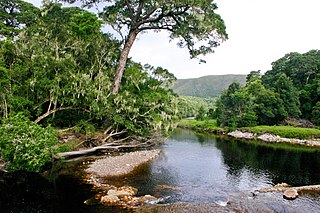
The Knysna-Amatole montane forests ecoregion, of the tropical and subtropical moist broadleaf forests biome, is in South Africa. It covers an Afromontane area of 3,100 square kilometres (1,200 sq mi) in the Eastern Cape and Western Cape provinces.

Olea capensis, also known by the common name black ironwood, is an African tree species belonging to the Olive family (Oleaceae). It is widespread in Sub-Saharan Africa from the east in Somalia, Ethiopia and Sudan, south to the tip of South Africa, and west to Cameroon, Sierra Leone and the Islands of the Gulf of Guinea, as well as Madagascar and the Comoros. It occurs in bush, littoral scrub and evergreen forest.
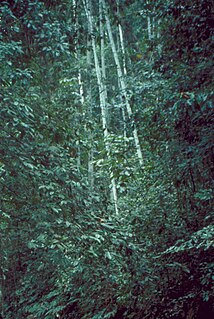
The Amani Nature Reserve is a protected area located within the Muheza and Korogwe Districts in the Tanga Region of Tanzania, in tropical East Africa.
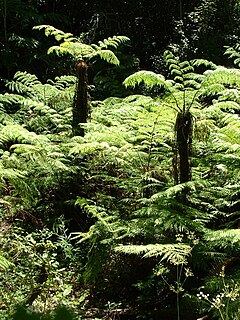
Alsophila capensis, synonym Cyathea capensis, is a regionally widespread and highly variable species of tree fern. It is indigenous to Southern Africa and South America.

The Himalayan subtropical broadleaf forests is an ecoregion that extends from the middle hills of central Nepal through Darjeeling into Bhutan and also into the Indian States of Uttar Pradesh and Bihar. It represents the east-west-directed band of subtropical broadleaf forest at an altitude of between 500 to 1,000 m along the Outer Himalayan Range, and includes several forest types traversing an east to west moisture gradient.

Southern Afrotemperate Forest is a kind of tall, shady, multilayered indigenous South African forest. This is the main forest-type in the south-western part of South Africa, naturally extending from the Cape Peninsula in the west, as far as Port Elizabeth in the east. In this range, it usually occurs in small forest pockets, surrounded by fynbos vegetation.

Olea hochstetteri is a species of tree of the family Oleaceae. It is often seen as synonymous with a subspecies of the black ironwood, namely O. c. subsp. macrocarpa, which is however native to Afromontane forest from East to southern Africa. Like the related species Olea welwitschii, it grows in sandy desert regions of Kenya, Tanzania and Uganda. It is an inconspicuous plant that does not attain great height, in contrast to O. welwitschii which can attain a height of 25 metres.
Agelanthus pennatulus is a species of hemiparasitic plant in the family Loranthaceae, which is found in Tanzania, and Kenya.
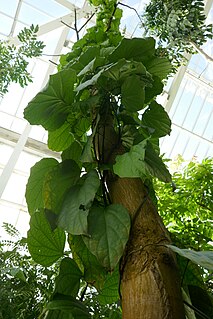
Lannea welwitschii is a species of tree in the family Anacardiaceae. It is native to the tropical rainforests of West and Central Africa. The timber is used to make furniture and utensils and for many other purposes, the fruits can be eaten, and the bark is used to produce a dye, for making rope and in traditional medicine.

The Somali montane xeric shrublands is a desert and xeric scrubland ecoregion in Somalia. The ecoregion lies in the rugged Karkaar Mountains, which run parallel and close to Somalia's northern coast on the Gulf of Aden, and follows northern Somalia's Arabian Sea coast from Cape Guardafui south to Eyl.

The Victoria Basin forest-grassland mosaic is an ecoregion that lies mostly in Uganda and extends into neighboring countries. The ecoregion is centered north and west of Lake Victoria, with an outlier on the border of Ethiopia and South Sudan.
Mimusops laurifolia is a large evergreen tree, native to the Ethiopian Highlands and the highlands of southeastern Arabian Peninsula.














